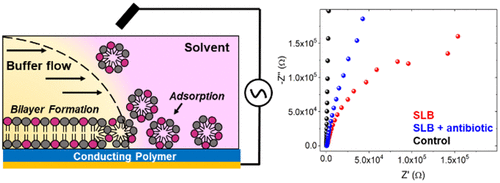
Membrane biosensors that can rapidly sense pathogen interaction and disrupting agents are needed to identify and screen new drugs to combat antibiotic resistance. Bioelectronic devices have the capability to read out both ionic and electrical signals, but their compatibility with biological membranes is somewhat limited. Supported lipid bilayers (SLBs) have served as useful biomimetics for a myriad of research topics involving biological membranes. However, SLBs are traditionally made on inert, rigid, inorganic surfaces. Here, we demonstrate a versatile and facile method for generating SLBs on a conducting polymer device using a solvent-assisted lipid bilayer (SALB) technique. We use this bioelectronic device to form both mammalian and bacterial membrane mimetics to sense the membrane interactions with a bacterial toxin (α-hemolysin) and an antibiotic compound (polymyxin B), respectively. Our results show that we can form high quality bilayers of both types and sense these particular interactions with them, discriminating between pore formation, in the case of α-hemolysin, and disruption of the bilayer, in the case of polymyxin B. The SALB formation method is compatible with many membrane compositions that will not form via common vesicle fusion methods and works well in microfluidic devices. This, combined with the massive parallelization possible for the fabrication of electronic devices, can lead to miniaturized multiplexed devices for rapid data acquisition necessary to identify antibiotic targets that specifically disrupt bacterial, but not mammalian membranes, or identify bacterial toxins that strongly interact with mammalian membranes.


"KAUST shall be a beacon for peace, hope and reconciliation, and shall serve the people of the Kingdom and the world."
King Abdullah bin Abdulaziz Al Saud, 1924 – 2015
Thuwal 23955-6900, Kingdom of Saudi Arabia
© King Abdullah University of Science and Technology. All rights reserved